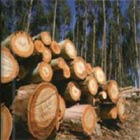



Context - Forests cover a third of our planet's land.
They provide raw materials, maintain biodiversity, protect land and water resources, and play a role in climate change mitigation.
Forests are heavily exploited, but important efforts are being made to use and manage them more sustainably.
What is the current state of the world's forests?
This Digest is a faithful summary of the leading scientific consensus report produced in 2006 by the Food & Agriculture Organization (FAO): "Global Forest Resources Assessment 2005, Progress towards sustainable forest management![]()
The world’s forests fulfill many roles such as providing renewable raw materials and energy, maintaining biodiversity, and protecting land and water resources. However, they can be damaged by fire, agricultural and urban expansion, and other disturbances.
The Food and Agriculture Organization of the United Nations (FAO) collected and assessed information from 229 countries and territories for three points in time: 1990, 2000, and 2005. This assessment sheds light on overall progress towards sustainable forest management at both global and regional level. More...
The area of land covered by forests is a key piece of information for forest policy in a country or region. More...
2.1 About 30% of the global total land area is covered by forests, this amounts to just under 40 million km2. This corresponds to an area roughly the size of a football field for every person on the planet, but it is unevenly distributed. More...
2.2 Deforestation, mainly conversion of forests to agricultural land, is continuing at an alarmingly high rate. Forest area decreased worldwide by 0.22% per year in the period 1990-2000 and 0.18% per year between 2000 and 2005. However, the net loss of forest is slowing down as a result of the planting of new forests and of natural expansion of forests. More...
2.3 Primary forests account for over a third of global forest area, but 60 000 km2 (an area roughly the size of Ireland) continue to be lost or modified by logging or other human interventions each year. Forest plantations are increasing but make up less than 5% of overall forest area. The remainder are mainly modified natural forests, but also semi-natural forests. More...
Forests influence climate change mainly by affecting the amount of carbon dioxide in the atmosphere. When forests grow, carbon is removed from the atmosphere and absorbed in wood, leaves and soil. Because forests can absorb and store carbon over an extended period of time, they are considered “carbon sinks”. This carbon remains stored in the forest ecosystem, but can be released into the atmosphere when forests are burned. Overall, the world’s forest ecosystems are estimated to store more carbon than the entire atmosphere. More...
Biological diversity allows forest ecosystems to adapt continuously to changing conditions and to maintain their potential for meeting human needs. More...
4.1 The amount of primary forest provides a basic indication of biodiversity. Nearly half of the primary forest is found in South America, a quarter in North and Central America, and nearly a fifth in the Russian Federation alone. Several countries, mostly in Europe and in the arid zones of Africa and Western Asia, have no primary forests left. More...
4.2 Protected areas of forest are important to conserve biological diversity, although many areas outside protected areas are also managed for conservation purposes. The area of forest designated specifically for biodiversity conservation has increased significantly over the past 15 years. It now exceeds 11% of total forest area. More...
4.3 The number of native tree species found in different countries varies greatly. In general, the highest number of species is found in countries located in the humid tropics and the lowest in those with boreal forests. The most common tree species appear to have remained the same in most countries over the last 15 years. More...
4.4 Rare tree species and those with high economic value are often in danger of becoming locally extinct. On average, 5% of the tree species native to a country are threatened. There does not seem to be a clear relationship between loss of forest and number of threatened tree species. More...

Forests can be damaged by disturbances such as fires, airborne pollution, storms, invasive species, pests, diseases, and insects. More...
5.1 About 1% of forests (an area roughly the size of New Zealand) are consumed by fire each year, causing casualties, economic damage, loss of biodiversity and release of carbon to the atmosphere. Nowadays, most forest fires are caused by humans. More...
5.2 Problems caused by insects and diseases have increased in recent years, being spread by long-distance air travel and increased international agricultural and forest product trade. Globally, 3% of forest area is reported to be affected by insects and diseases. More...
5.3 Other forest disturbances include climatic factors such as wind, snow, ice, floods, tropical storms and drought, or impacts of animals such as deer and rodents. In Europe, the average area of forest affected by disturbances in a year almost doubled between 1990 and 2000 due to the effects of severe storms such as those that hit Western Europe in December 1999. More...

Forests provide a wide range of products, not only timber and fuelwood, but also products such as food (berries, mushrooms, etc.) and fodder. More...
6.1 Wood production continues to be an important function of many forests. One third of the world’s forests are used primarily for production of wood and other forest products. Most of these are natural or semi-natural forests. Forests planted specifically to supply wood and other forest products make up less than 3% of the global forest area, but supply a substantial proportion of forest products. More...
6.2 The growing stock is the amount of stemwood in a given area. It provides an indication of how much biomass and carbon is stored in the forest. Overall, growing stock has decreased slightly between 1990 and 2005. About 30% of the total growing stock is found in South America. More...
6.3 The volume of timber and fuelwood harvested has remained constant over the last fifteen years. More...
6.4 Non-wood forest products are important for many people living in or near forests. Such products include food (such as berries, mushrooms, edible plants, and game, exudates (such as plant resins and latex), medicinal and aromatic plants, fodder, ornamental plants (like Christmas trees), and other plant products (such as tendu leaves used to make bidis). More...
Beyond providing wood and other products, trees play a role in the conservation of ecosystems, in maintaining clean water, and in preventing or reducing the severity of floods, avalanches, erosion, and drought. More...
7.1 An increasing area of the world’s forests is designated primarily for soil and water conservation. More...
7.2 Recognizing the important protective role of forests, many countries have planted trees for this purpose. These protective forest plantations cover an area the size of Italy or a little less than 1% of the world’s forests. More...
Forests provide a wide range of economic and social benefits, such as employment, forest products, and protection of sites of cultural value. More...
8.1 The total value of harvested timber and fuelwood was about US$64 billion in 2005. When taking the inflation into account, this value has been decreasing over the past 15 years. More...
8.2 The total global reported value of non-wood forest products was US$4.7 billion in 2005. However, since information on the value of those products is incomplete it is likely an underestimate of the true value. More...
8.3 Some 10 million people are employed in forestry or in forest conservation and management activities, mainly in India and China. More...
8.4 Most of the world’s forests are publicly owned (84%), but private ownership is increasing. In some regions, this reflects a trend towards community empowerment, decentralised decision making, and increased involvement of the private sector in forest management. More...
8.5 Use of forests for recreation and education is increasing, but difficult to quantify. In Europe, nearly three quarters of the forest area provide social services, often in combination with other management objectives. More...

There are many good signs and positive trends, but also many negative trends, all depending on the scale considered. More...
9.1 At the global level, there has been a decrease in the area of forest, as well as in the area of primary forest and in employment in the forest sector, and an increase in the forest area affected by insects, diseases and other disturbances. On a positive note, more forest area has been designated for biodiversity protection and social services. More...
9.2 In Africa, overall, there was limited progress towards sustainable forest management, with continued rapid loss of forest area. In Asia, progress has been mixed. Overall forest area was almost the same in 2005 as in 1990, thanks to large-scale efforts to replant forest, particularly in China. However, a rapid decline of primary forest is cause for concern. In Europe, the status of forest has mainly been stable, although the severe storms of 1999 affected forest health. Forest management has progressed in North and Central America as a whole, although there is a considerable variation between sub-regions. Progress in South America was mixed; the rapid net loss of forest area and the loss of primary forest are cause for concern. However there has been an increase in areas of forest being set aside for biodiversity conservation and social services. More...
9.3 Within world regions there are local differences. For instance trends were more negative in Eastern and Southern regions of Africa compared to the rest of the continent, in Central America compared to North America and the Caribbean, and in South and Southeast Asia compared to East Asia. More...
The 2005 Forest Resource Assessment is the most comprehensive assessment of forests to date, in terms of both content and number of contributors. It tells us that forests cover 30% of the land area of planet Earth and range from undisturbed primary forests to forests managed and used for a variety of purposes.
The assessment also tells us that deforestation continues at an alarmingly high rate, but that the net loss of forest area is slowing down thanks to forest planting, landscape restoration and natural expansion of forests on abandoned land. Forests are increasingly being conserved and managed for multiple uses and values. They play a crucial role in climate change mitigation and in the conservation of biodiversity as well as of soil and water resources. If managed sustainably, forests also contribute significantly to local and national economies and to the well-being of current and future generations.
The assessment of progress towards sustainable forest management depends on the context, the scale and the perspective applied. At the global level, the world’s forest resources appear to be in relatively good shape. However, at regional and subregional level, this picture changes dramatically revealing considerable differences, with alarming trends in several tropical subregions.
Considerable efforts will be needed to address remaining negative trends in order to progress towards sustainable forest management in all countries and regions. More...

This summary is free and ad-free, as is all of our content. You can help us remain free and independant as well as to develop new ways to communicate science by becoming a Patron!